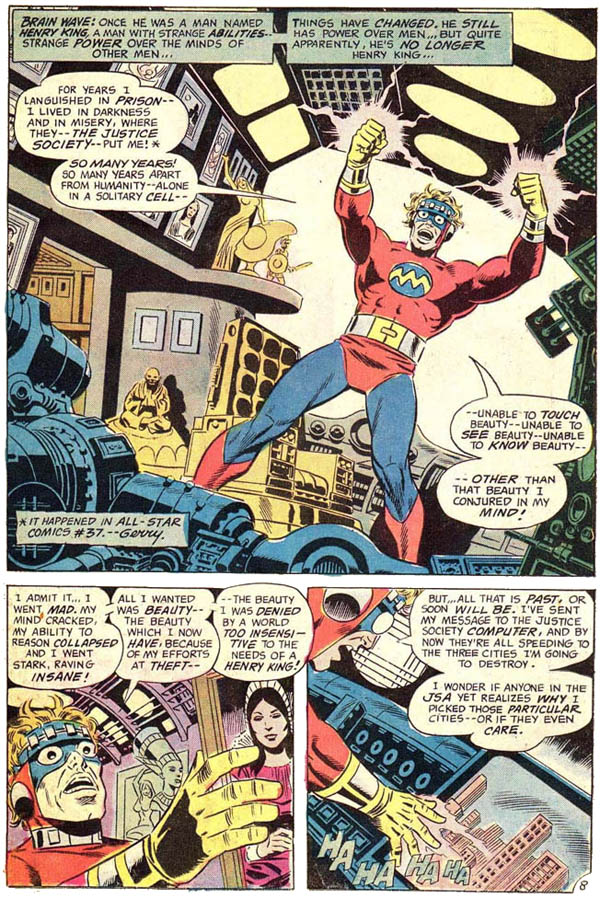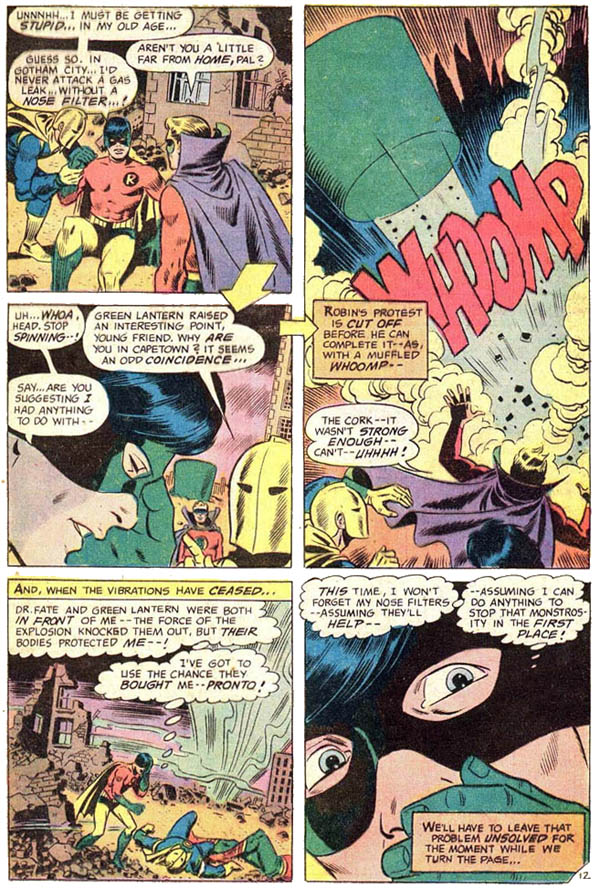Or – “Her… Um… Character Wasn’t Quite As Large Then.”
There’s an urban legend in comics that inker Wally Wood (known for his rendition of very buxom and attractive women) made a point of inserting the type of figures that he loved into his inking jobs for DC, to the point where a new character in All-Star Comics became so buxom that it has become an intrinsic part of her character even 40 years later. Are you ready for the first appearance of Power Girl?
 ALL-STAR COMICS #58
ALL-STAR COMICS #58
Scripter: Gerry Conway
Penciler: Ric Estrada
Inks: Wally Wood
Cover Art: Mike Grell
Colorist: Uncredited
Letterer: Uncredited?
Editor: Gerry Conway
Publisher: DC Comics
Cover Price: 25 Cents (Current Near-Mint Price: $80)
Previously, on All-Star Comics: The original super-team, the Justice Society of America had originally debuted in All-Star Comics #3, and rode that title for another fifty-odd issues before suddenly getting replaced with ‘All-Star Western.’ Superhero titles went by the wayside for half a decade, until the advent of Barry Allen and Hal Jordan changed everything we knew about comic books. The new Flash and Green Lantern led to a new super-team, which inevitably led to team-ups and crossovers with the Justice Society, now headquartered on the alternate world of Earth-2. 25 years after their ignominious exit, the Justice Society and All-Star Comics both returned in America’s Bicentennial year, and not much had changed during their absence. In the first issue of the relaunched All-Star Comics (#58, continuing from 1951’s #57 and ignoring the issues of All-Star Western that followed), the JSA faces a threat to the ENTIRE WORLD!!!
It’s an interesting line-up of heroes here, with original chairman Hawkman (the only hero to appear throughout the team’s 40’s run) teamed up with The Flash, Green Lantern Alan Scott, late replacement Doctor Mid-Nite and Wildcat, who had only made a couple of appearances in the Golden Age. Notably, characters who had identical duplicates (Superman, Batman, Wonder Woman) were absent from this team. As the team rushed off to save the day, we check up with the Star-Spangled Kid, whose backstory is complicated as all hell: A wartime member of the Seven Soldiers of Victory, he was lost in time, then brought back and was awarded the cosmic rod of Starman to use due to Starman’s age and injuries. Of course, SSK isn’t exactly untouched by his ‘man out of time’ status…
At this stage in the game, Marvel Comics had gone from upstart company to new top dog, and the Kid’s problems here owe a lot to Stan Lee’s characterization of Steve Rogers after he came out of the iceberg… As with many of the titles around this time, though, there isn’t a lot of space to worry about it (thanks to a lower page count due to a paper shortage) as Doctor Mid-Nite and Hawkman arrive to help him deal with the earthquake. Is it really Mid-Nite’s portent of doom come to life, or is there something else going on?
Yeah, it’s something else in the form of the Brain Wave, one of the Justice Society’s oldest foes, albeit in a whole new form. In Capetown, South Africa, we catch up with another old friend in the form of United Nations ambassador Dick Grayson, the artist formerly known as Robin. There’s an odd discussion of apartheid that seems feels prescient, since I normally associate that with the mid-80’s era, but Brain Wave’s machines force Robin into action just in time to meet up with Doctor Fate and Green Lantern of the JSA!
The grown-up Robin gives us the Batman-boost that every comic book has to have (according to Stephen, anyway) and we’re left with the powerless Adult Wonder last man standing to save the ultra-powerful mage and ring-slinger. Of course, that has to happen in the future, as we head off to Peking (also known as Bejing) the capital of China. Flash and Wildcat leap into action against a volcano, only to find themselves assisted by a mysterious blonde in a kinda familiar universe. The powerful young lady takes care of the entire crisis single-handedly, irritating Wildcat, who reminds her of the power of a mean right cross. The three heroes set off to follow up on their mysterious disaster master, but are a bit suspicious to discover that she knows a lot more about the situation than the JSA does…
I’m not sure if it’s Gerry Conway’s distinctive no-holds-barred writing style or the cramped page-count that does it, but this issue feels particularly rushed, as though it were created for more pages and retrofitted to this length. Power Girl’s appearance is treated as just another thing that happened, with only a quick footnote to mention her counterpart on Earth-1. The art is a weird melange of Ric Estrada’s style and the VERY strong inks of Wally Wood, causing the art to flip back and forth as to which artist is dominant. Since I adore Wally’s style, but don’t have the same love for Ric, it makes the reading experience a little bit whiplashy. Even though the abbreviated debut feels unsatisfying, I’m sure if she showed up today, she’d have a six-issue arc dedicated to giving us everything about her origins and such, leaving her in the perfect position to be broken down to mush. Overall, the issue (while historic) doesn’t necessarily hold up four decades down the road, leaving All-Star Comics #58 with a breathless but still respectable 2.5 out of 5 stars overall.
Faithful Spoilerite Question Of The Day: With all the changes going on at DC, why is the impending sabbatical of the JSA such a polarizing issue?









10 Comments
Great review. I think that at this point it’s just a nice historical tie the DCU has to its origins as a rag-tag 40s company(ies) it once was. It was also a series that was able to give bland Superman/Batman ripoff characters their own unique personalities. Maybe people like me like the legacy idea that has been present since Robinson revamped the series in the 90s(?). However for me, the JSA has not been a good read since Willingham left the book, which to me was a solid run (even if some stories were a tad derivative), and Guggenheim’s cluster-schmoz of story telling finally made me drop it.
I love stuff like this for all the reasons it’s supposed to be “bad.” I think the art and writing, both rushed and kinda unrealistic, leave more to the imagination.
I want my original recipe Earth-2 JSA!
I think fan reaction to the JSA is polarizing for two reasons:
1) The recent JSA has been horrible, and does not feel like it has respect for “Legacy” characters.
2) The post-Starman JSA revival was initially wonderful, and showed deep respect to many “Legacy” characters.
“Sooner or later, everything turns to crap.” We wish it didn’t, but it does. The JSA went to crap before the DC Re####, so we can’t blame the Re####…and it isn’t being brought back as part of the Re#### so we can’t even hope for a rescue…and we won’t get to experience schadenfreude.
I have to disagree on the recent portrayal of the JSA. It’s only by certain plot devices that Carter Hall (reincarnation), Alan Scott (Starheart Energies), Jay Garrick (Speed Force) and Ted Grant (“nine lives”) are still around while all the rest of their WWII era partners are now Black Lantern recruit material and I think that they have been handled pretty well since the close of the “JSA” series (with the exception of that damn awful Green Lantern costume).
Actually, I think I still have that issue somewhere back in storage and remember it quite well. If the “re####” (which is a great term, by the way) ended up with the “Golden Age Characters” moving back to the “Earth-2” of this multiverse I would have no problem with that if it would allow the Golden Age legacy heroes (Atom Smasher, Hourman II, Jessie Quick, Kent Nelson II, etc.) to continue. However, the announcement that Mr. Terrific is getting his own series kinda leaves that in doubt.
While this issue does have its flaws, this run is pure greatness IMO. While I liked a lot of the modern JSA, those characters have never worked as well once they were shoe-horned into the never changing main DCU. Some of my favorite memories as a new comic fan were tracking down issues from this run in the late 70’s/early 80’s.
I think Guggenhiem was too busy focusing on his fantastic limited series Halcyon to be able to give enough attention to the JSA. I read two issues and decided to drop the series from my list. Johns and Willingham treated the characters with the respect that Robinson reminded us that they deserve.
Since the re###### is supposed to focus on the earlier years of the DCU, why didn’t they have a JSA book set in the 40’s? Do we REALLY need Hawk and Dove? Seriously? This is not my dislike of Liefeld shining through, either. I have no faith in the characters to be able to hold their own series.
Just a question about the segment of this issue featuring Powergirl and Wildcat, but why is she hopping around holding onto him, why doesn’t she just fly?
At this point in the continuity, I believe, Earth-2 Kryptonians couldn’t actually fly, just leap tall buildings in a single bound, as Superman did in the late 30’s (to differentiate the two characters.)
So I take it that Stephen prefers this characterization then. lol. He’s all about the leaping tall buildings.
i guess you had to have been there. i was in 8th grade. this comic was an instant classic to me. being 13, nearly 14, at the time, the first appearance of power girl was a BIG deal! lol i really liked robin’s new costume much better than the previous batman-robin combination costume he had worn in the previous year’s jsa-jla team-up.